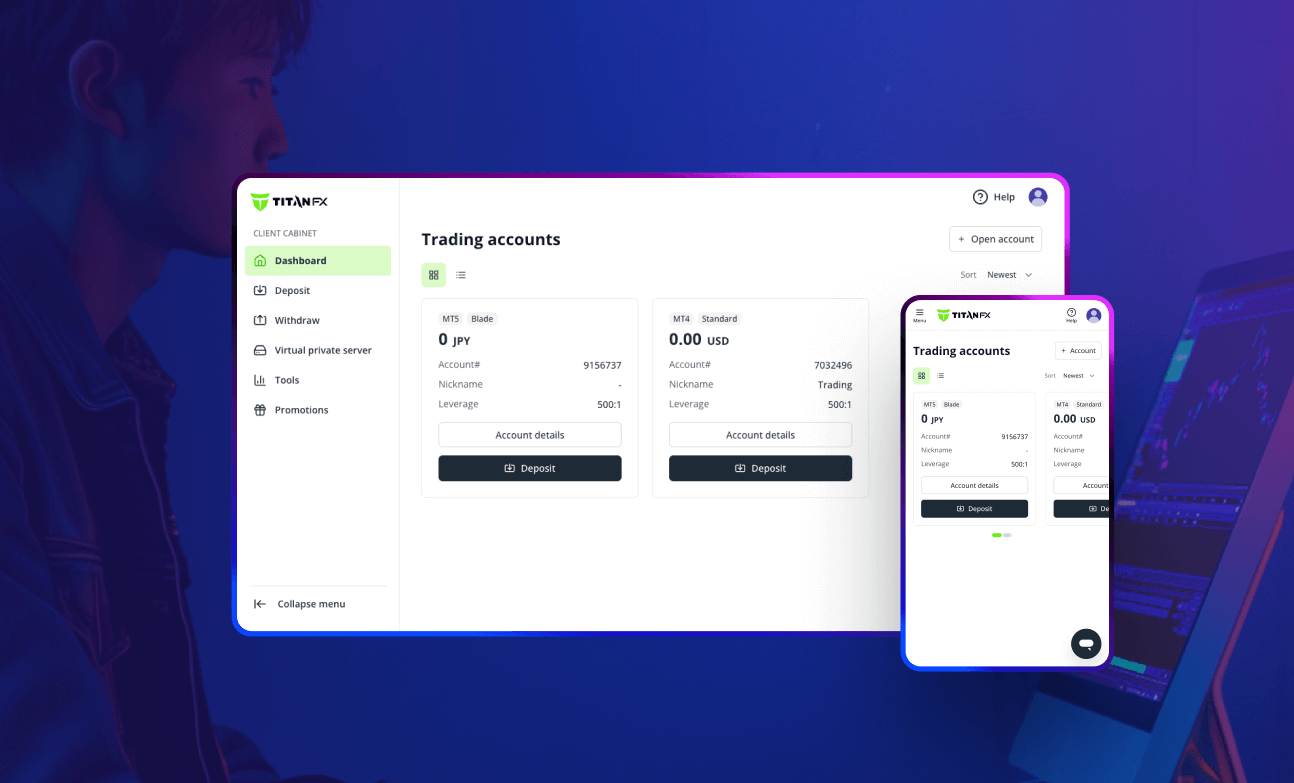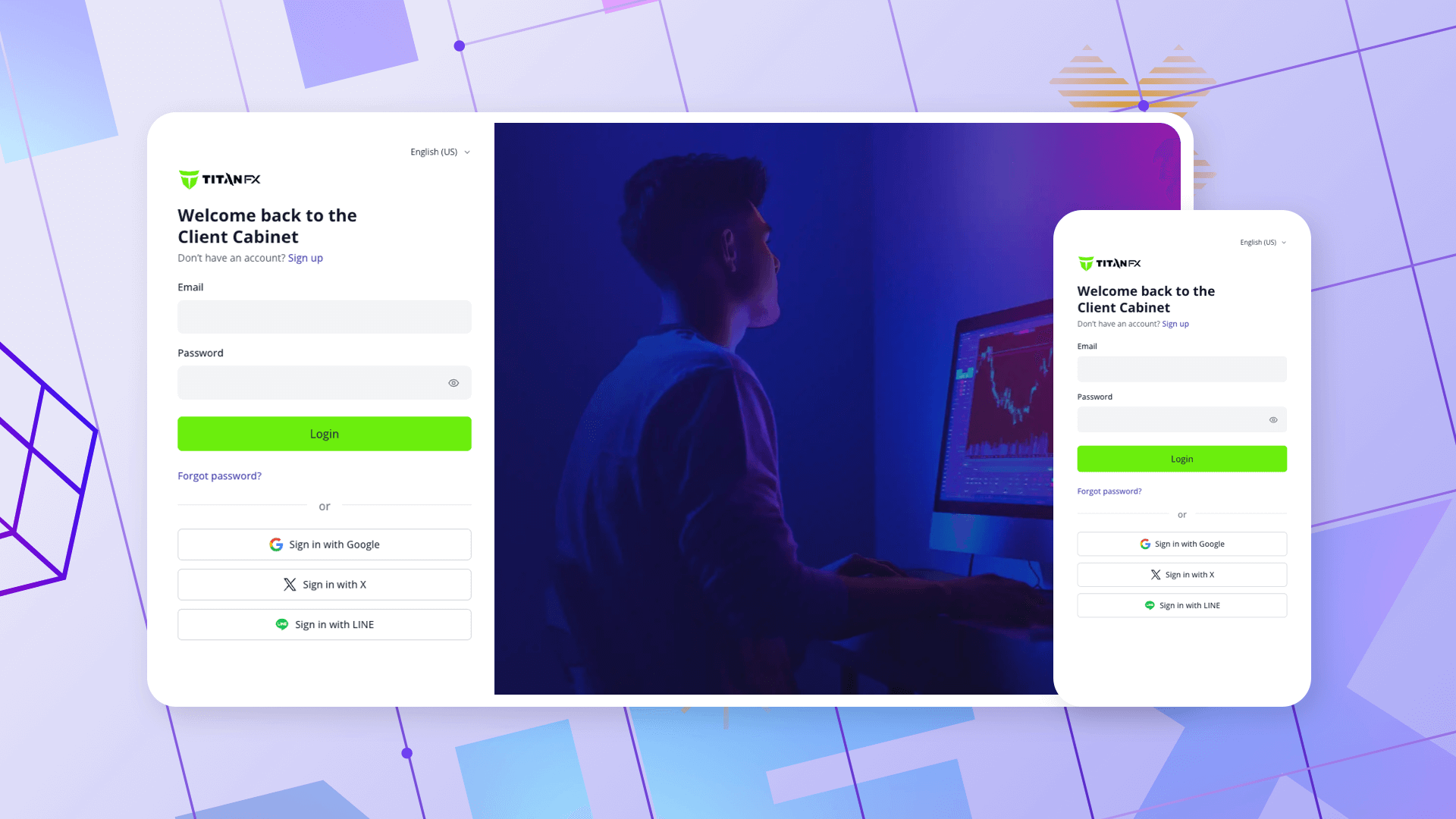Project Overview
TitanFX's client-facing trading dashboard was built on legacy CodeIgniter with jQuery, creating significant challenges for both users and developers. After an initial attempt in September 2023 that stalled due to lack of UX direction, I led a successful restart in November 2024 that transformed this critical platform into a modern, high-performing application serving thousands of traders globally.

The Challenge
Legacy System Reality
The existing platform was a classic example of technical debt accumulation:
Legacy Technology Stack: Built on CodeIgniter with jQuery, featuring a chaotic mix of SASS and LESS stylesheets that made styling inconsistent and maintenance nightmarish.
Poor Performance: Lighthouse scores significantly lagged behind modern standards, with slow page loads and suboptimal user experience metrics.
Developer Experience Nightmare: No component reusability, inconsistent styling approaches, and complex deployment processes that slowed development to a crawl.
Fragmented User Experience: Multiple disconnected interfaces for deposits, withdrawals, and account management with non-responsive design patterns.
The False Start (September 2023)
The initial modernization effort began in September 2023 but quickly stalled due to a critical gap: no dedicated UX expertise. Without clear design direction and user experience strategy, the technical implementation lacked focus and purpose. This taught us a valuable lesson about the interdependence of technical and design excellence.
The Strategic Restart (November 2024)
Learning from the initial setback, we restructured the approach with proper UX leadership and clear design direction. This time, we had:
- UX-First Approach: Dedicated design resources and user research to guide technical decisions
- Clear Vision: Modern interface with professional trading platform expectations
- Performance Goals: Specific targets for Lighthouse score improvements
- Developer Experience Focus: Emphasis on improving development velocity and code maintainability
Solution Architecture
Technology Modernization Strategy
I recommended and implemented a comprehensive technology upgrade:
Next.js Foundation: Chose Next.js for its excellent developer experience, built-in performance optimizations, and server-side rendering capabilities that would dramatically improve our Lighthouse scores.
React Component Architecture: Implemented a component-driven approach that eliminated the jQuery spaghetti code and created reusable, maintainable UI elements.
TypeScript Implementation: Full TypeScript adoption to catch errors early and improve developer confidence, especially important when migrating from loosely-typed legacy code.
Design System Approach: Leveraged Tailwind CSS with Shadcn/Radix components to create a consistent, accessible design language that eliminated the SASS/LESS chaos.
UX/DX Improvement Focus
User Experience Transformation:
- Modern, responsive design that works seamlessly across all devices
- Intuitive navigation patterns inspired by leading trading platforms
- Real-time updates and smooth interactions that feel native and responsive
- Accessibility-first approach ensuring inclusive user experience

Developer Experience Revolution:
- Prettier Integration: Automated code formatting ensuring consistent style across the team
- ESLint Configuration: Comprehensive linting rules for code quality and best practices
- Bitbucket Pipelines: Automated CI/CD pipeline for testing and deployment
- Automatic Translation Sync: Streamlined localization workflow reducing manual overhead
- Commitlint: Enforced conventional commit messages for better project history
- Component Library: Storybook documentation for consistent development patterns
- Hot Module Replacement: Immediate feedback during development with fast refresh
- TypeScript Integration: Clear interfaces serving as documentation and preventing runtime errors
Implementation Journey
UX Research and Design: Collaborated closely with UX team to understand user workflows and pain points in the existing CodeIgniter system.
Technical Foundation: Established Next.js project structure with proper TypeScript configuration, focusing on developer experience from day one.
Design System Creation: Built a comprehensive component library using Storybook, ensuring every component was documented and accessible.
Strategic Migration Approach: Rather than a big-bang rewrite, implemented a gradual migration strategy that allowed for continuous user feedback and iterative improvements.
Performance-First Development: Every component and page was built with Lighthouse metrics in mind, resulting in significant performance improvements over the legacy system.
Modern Trading Interface: Created deposit and withdrawal interfaces that rival industry leaders, with real-time validation and smooth user flows.
Technical Achievements
Performance Breakthrough
60% Lighthouse Score Improvement: The most significant achievement was dramatically improving our Lighthouse performance scores compared to the legacy CodeIgniter system. This improvement directly translated to better user experience and higher user engagement.
Bundle Optimization: Implemented code splitting and lazy loading strategies that reduced initial bundle size and improved page load times significantly.
Modern Browser Optimization: Leveraged Next.js optimization features including automatic image optimization, font optimization, and efficient caching strategies.
Developer Experience Revolution
Development Velocity: Achieved 70% faster development cycles through component reusability and improved developer tooling.
Code Quality: Significant improvement through TypeScript implementation, automated tooling (Prettier, ESLint, Commitlint), and comprehensive testing strategies.
Maintainability: Eliminated the technical debt of mixed SASS/LESS stylesheets with a consistent Tailwind-based design system.
User Experience Transformation
Modern Interface Standards: Created a clean, intuitive interface that matches modern trading platform expectations.
Responsive Design: Seamless experience across desktop, tablet, and mobile devices.
Accessibility Compliance: Full keyboard navigation and screen reader support, ensuring inclusive access to trading features.
Team Leadership and Collaboration
Cross-Functional Success
UX Partnership: Worked closely with UX designers to translate research insights into technical implementation, ensuring every component served real user needs.
Backend Collaboration: Coordinated with backend teams to optimize API design for frontend performance and user experience.
Knowledge Transfer: Mentored team members on modern React patterns and TypeScript best practices, ensuring project sustainability.
Process Improvements
Development Workflow: Established Git flow processes, Bitbucket Pipelines for CI/CD, and code review standards that maintained quality while enabling rapid iteration.
Developer Tooling: Implemented Prettier for consistent formatting, ESLint for code quality, and Commitlint for standardized commit messages.
Automation Systems: Set up automatic translation sync reducing manual localization overhead and Bitbucket Pipelines for seamless deployment.
Documentation Culture: Created comprehensive documentation that enabled new team members to contribute effectively within days rather than weeks.
Quality Assurance: Implemented automated testing strategies that caught issues before they reached users.
Results and Business Impact
Performance Metrics
Lighthouse Score Achievement: 60% improvement over legacy system, directly correlating with improved user satisfaction and engagement.
User Experience Enhancement: Significant reduction in user-reported issues and support tickets related to interface problems.
Development Efficiency: Team productivity increased by 70% due to improved tooling and component reusability.
Long-term Value
Scalable Architecture: Created a foundation that enables rapid feature development and easy maintenance.
Technical Debt Elimination: Replaced legacy CodeIgniter/jQuery codebase with modern, maintainable technology stack.
Team Capability Growth: Enhanced team skills in modern frontend development, TypeScript, and performance optimization.
Key Learnings
Project Management Insights
UX-First Approach: The initial failure taught us that technical excellence without UX direction leads to unfocused development. The successful restart prioritized user experience research and design before technical implementation.
Incremental Migration: Gradual migration strategies work better than big-bang rewrites, allowing for continuous user feedback and reduced risk.
Performance Metrics: Having specific, measurable performance goals (like Lighthouse scores) provides clear success criteria and motivates technical decisions.
Technical Lessons
Modern Tooling ROI: The investment in modern development tools and practices pays immediate dividends in developer productivity and code quality.
Component-Driven Development: Building reusable components from the start dramatically improves long-term maintainability and development velocity.
TypeScript Value: The transition from loosely-typed legacy code to TypeScript provides immediate improvements in developer confidence and code reliability.
Future Foundation
The modernized platform establishes a strong foundation for future enhancements:
Performance Leadership: With 60% better Lighthouse scores, the platform now meets modern performance standards and can support advanced features.
Developer Productivity: The improved developer experience enables rapid feature development and easier maintenance.
User Experience Excellence: Modern interface patterns and responsive design provide a foundation for enhanced trading features.
Scalable Architecture: Component-driven architecture supports future expansion and feature development.
Conclusion
This project demonstrates the critical importance of combining technical excellence with user experience focus. The initial failure in September 2023 taught valuable lessons about the interdependence of UX and technical implementation. The successful restart in November 2024 shows how proper planning, modern technology choices, and UX-driven development can transform both developer productivity and user satisfaction.
The 60% improvement in Lighthouse scores represents more than just technical metrics—it reflects a fundamental transformation in how we approach frontend development, prioritizing performance, maintainability, and user experience in equal measure.